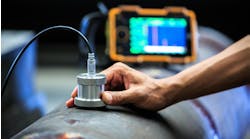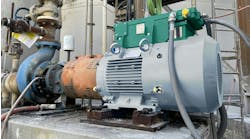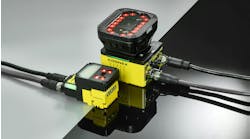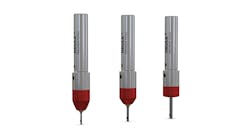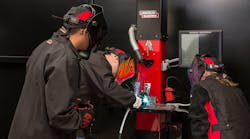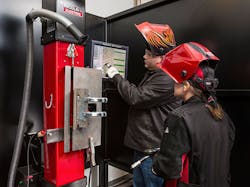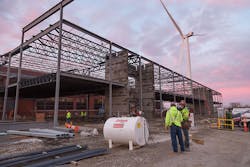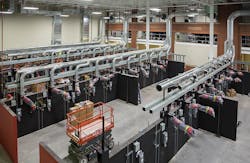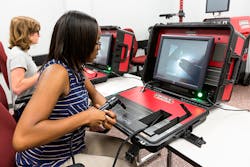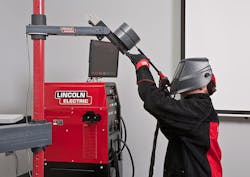For more on this subject, Lincoln Electric CEO Chris Mapes will be presenting the keynote Automation and Education: Addressing the Nation's Skills Gaps at IndustryWeek's Manufacturing & Technology Conference on May 9.
Ratty coveralls soaked in sweat and soot. Blinding sparks careening off a white-hot ball of energy mere inches from your face. A plume of smoke perpetually mingling around the acrid smell of melted metal and a steady stream of crude jokes. A blue-collar yoke tying you to middling pay and manual labor.
Mention the word "welding" to anyone outside the industry and this is the image it inevitably creates. But, like with so many other fields in today's advanced manufacturing world, that image is far out of date.
With around two decades of experience behind him, Jason Scales, the business manager for educational solutions at Lincoln Electric, knows these dirty, dark, and dangerous stereotypes all too well.
"A grumpy old, dirty industry—that's still what a lot of people imagine welding to be," the former agriculture mechanics teacher says. "But welding is a far advanced industry, very scientific with a lot of technology in it, and it often is a clean environment."
This is a familiar story in manufacturing today—tainted by outdated notions and bad PR, manufacturing leaders find themselves forced to constantly evangelize the progress and potential of these critical industries just to keep the applicant pool alive.
But now, Scales and the rest of Lincoln Electric have a new tool at their disposal to help do away with these manufacturing myths.
It comes in the form of Lincoln Electric's brand new $30 million Welding Technology & Training Center—a facility custom designed to provide the most advanced, tech-filled, science-based environment for welders of every tier, from recent high school grads who have never held a torch to seasoned pros.
Essentially, this will put all that evangelizing into action, creating a new generation of welders who truly understand the latest tools and technologies of the trade, plus trainers qualified to take those lessons to plants far outside the program's direct reach.
Focusing on education might seem beyond the purview of a manufacturer, but Scales says for too long he's heard conflicting reports from schools who say their welding students can't find jobs and manufacturers who say they can't find people to fill welding jobs.
"That tells me there's a disconnect between what's going on in education at some institutions and what the industry truly needs from that institution," Scales says.
And this school, like the industry it serves, is all about fusing together what was once separate and providing a solid foundation on which to build.
No Train, No Gain
Situated just across the street from the company headquarters in Euclid, Ohio, Lincoln Electric's 130,000-ft², two-story Welding Technology & Training Center boasts 166 welding and cutting booths, 13 classrooms, six seminar rooms, a 100-seat auditorium, a cafeteria, and supply store. During a December tour of the building, Scales gets especially giddy pointing out a real first for Lincoln's welding school: showers. Welding is a lot cleaner than stereotypes will have believe, but you'll still use a 6,500° F torch tip to liquefy metal. Sweat and smoke are to be expected, and one wouldn't want to give people the wrong impression.
Over time, every type of welding certificate will be available to earn, and robotic welding programming will figure prominently in future curricula.
The sprawling facility—part college campus and part product showcase—will serve dual functions: first, as training ground for welding educators, new students, and upskilling professionals; and secondly, as an applied science lab where Lincoln can gather a more intimate understanding of how welders of every experience level interact with their equipment.
Neither strategy is new to the world's foremost welding company, which has been in the training game since 1917 when it began bestowing the basics to WWI soldiers and sailors. But by combining both under one roof, Scales says Lincoln's latest incarnation of its 101-year-old program (the longest continuously run program in existence) is "taking it to the next level."
It will showcase the latest in Lincoln's training line likely to be found at public and private welding schools at the high school, community college, and technical college level, most prominently the virtual reality simulator VRTEX 360 and the performance-tracking REALWELD welding training system, as well as newer machines used professionally, including the PowerWave S350 Advanced Process Welder and Aspect 375 AC/DC TIG Welder.
With all the equipment advantages, and as enjoyable as the completely finished building will be, churning out a new group of entry-level welders is not the end game, but merely the opening move.
"Our job here isn't to compete with our friends at the community college level," Scales says emphatically. "They provide a great service for students, a lot of training, [associates of arts] degrees.
"What our job here is to become a train-the-trainer facility, and we will also do applied research and share that information with [educators] so they can train students better to meet the industry needs of their local area or on a national basis."
He adds that the school may only graduate 200 basic welders a year, though they are more valuable to the industry while learning than doing.
"The information we glean from those 200 students, we're going to share with the masses," Scales says.
Flex space in the advanced lab area could also fit the latest in robotic welders, so a company can book time to try out the latest in that specialty.
This means, if John Deere's fabricators have to learn a complex welding technique for a new tractor chassis, for example, the manager can come to the campus for a few days and pick up the best methodologies to bring back to the factory.
It's hard not to be impressed by the model, and to trust that Lincoln Electric knows what it's doing when it comes to people. They have been way ahead on a number of worker-friendly initiatives, from being at the forefront of training women and minorities prior to World War II, to giving employees profit-sharing bonuses since the 1930s, to now going into their 70th consecutive layoff-free year.
Parents Just Don't Understand
This resource couldn't come at a more critical time for this industry. According to the Economics Public Institute, 52% of teenagers surveyed say they have no interest in manufacturing. Left unchecked, this could become a 2 million person problem by 2025, according to Deloitte's now infamous prediction. In this industry specifically, an American Welding Society study from 2015 indicated there could be a deficit of 290,000 workers by 2020.
"Part of that study was to try to figure out who the influencers were of students," says Patrick Henry, corporate director of education services for the AWS. "Parents and instructors are the number one and two influencers."
A 2016 SME survey showed that 20% of parents surveyed view manufacturing as an outdated and/or dirty work environment, and a quarter thought manufacturing didn't pay well.
This latter point, of course, is demonstrably false. For a half-year of training at a technical or community college, the median salary in the welding industry alone falls in the mid-$40,000 range. And there is endless opportunity for advancement beyond that.
"I have met welders who make six figures easily because they are willing to travel outside of their normal comfort zones," Henry says. "There is a lot of opportunity for those individuals. Those traveling up to North Dakota to work on a pipeline make very good money, and they are not saddled with some of the same kind of debt that their peers incur going to college and not finding jobs after."
So it makes absolute financial sense for parents to encourage their offspring to at least consider a welding career if they are uncertain about their future.
The issue, however, may not be just getting kids into the welding booths, but keeping them there. Bad experience early on in trade school with inexperienced or ineffective instructors can dash the ambitions of even the most enthusiastic student.
That's why one of the core efforts at Lincoln's new center will be training the trainers, who will go forth to evangelize the profession at every level and for every learner.
"Being an expert in the field doesn't mean you're an expert in transferring that knowledge," Lincoln Electric's Scales says. "Typically people try to teach the way they learn."
Some students might be auditory learners, others visual or kinesthetic, he notes. However they learn, he just wants each student to have that "aha" moment, when they finally "get it."
"Three weeks in a booth, they're not laying down a good weld, then all of a sudden they get the right angle and travel speed," he says.
Scales believes Lincoln's training tech and insights will provide to welding teachers will elicit quicker "ahas" across schools and plants, up on skyscrapers, and maybe someday inside hyperloop tunnels.
Raiders of the Lost Arc
As Scales mentioned, the essence of welding comes down to finding the best travel speed and angle of approach. The school will not stray from that in practice or in principle.
"We want to increase the efficiency of the learning process," explains Jason Schmidt, Lincoln Electric's manager of technical services. "How do we do it in a more efficient way and do it faster, as well as having the students being able to pass qualifications certifications faster?"
Even for the company that invented arc welding, the answer will take time, and due to the rapidly evolving nature of technology, what is true today might be completely different in five years, Scales acknowledges.
The solutions also won't be a panacea for every application, and won't just come from Lincoln's insights from students from its past and future classes. The many educators and professionals who will come through will be encouraged to not only pick up new tricks, but to offer their own.
"Everybody can come here to transfer knowledge," Scales says, "and then go back and improve productivity."
They will experiment with which lab exercises work, which don't, and how to balance the theoretical (aka boring) classroom work for a group of largely hands-on learners.
Recommending the right equipment and curriculum for different industries and regions will also be top of mind. The needs of automotive-heavy Michigan aren't the same as an Alabama's, which has more aerospace.
"A lot of instructors will say they buy equipment just because that's what their predecessor taught them," Schmidt says. "They really haven't figured out a way to utilize the newer technology to what it's capable of."
This starts with the VRTEX 360, created in 2009, which allows users to get comfortable with technique and accrue that all-important muscle memory from the repetitive motion, all while not burning any real materials (or their instructors). The welding stand is adjustable for several different types of welds and positions, and keeps track of a student's passes.
"They are getting instant feedback that tells them what to correct," Schmidt says. "And the instructor can monitor and see how well they're doing. That way they can correct their issues a lot faster."
An Iowa State study has tested the efficacy of VR welding using the VRTEX and recommends its use for new and veteran welders to ensure high quality.
The next phase, using the REALWELD, eases welders into using live torches to master stick, MIG, and flux-cored arc welding, while still tracking progress. With several students doing lab work at a time with one instructor, the REALWELD acts as a teacher's assistant, tracking weld speed, angles, aim, contact tip to work distance/arc length, and position in the weld. These can all be checked by the student or teacher on the included touchscreen.
It's not just the innovative machines that will speed up certifications and knowledge transfer. Lincoln engineered every inch of the welding booths to ensure plenty of personal space, and fabricated patented weld tables that can transform with a series of pins and collars to replicate the difficult welding scenarios, like lying on their backs.
"We can put students in very uncomfortable positions to weld, like they would do in the field," Scales says proudly.
A submerged arc station, which was not set up yet, will also be adjacent to the long rows of bays.
Overall, there will be hundreds of pieces of equipment new and old that can be set up to fit any training need, although we didn't see a giant aquarium tank for the lucrative world of underwater welding, where salaries for experienced divers can float around $100,000/year. Lake Erie is less than 2 miles north, so maybe a field trip?
The plan, Schmidt says, is to also roll out alpha and beta units of new products for the students passing through to work with, which could have an immediate impact on the industry via more optimized machines.
"We will be able to discover and can address new features to new products that will advance our technology that much faster," Schmidt says.
With the first students at the center only now learning the basics, it will be many months before they start filling some of those vacancies, and it will be even longer before Lincoln-trained teachers can implement the methodologies and best practices to affect sweeping change of the industry. But if it works—and that can be quantifiably measured by comparing time to certification and quality of welds—this could be a system every other maligned trade, from machinists to electricians, may want to emulate to solve their share of the skills shortage.
